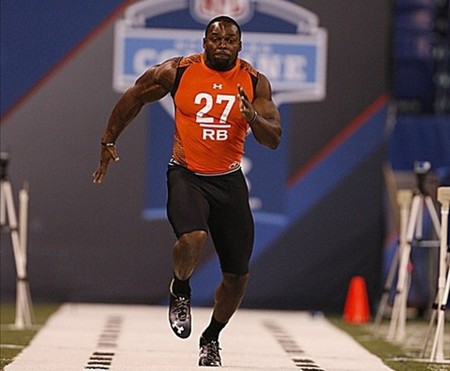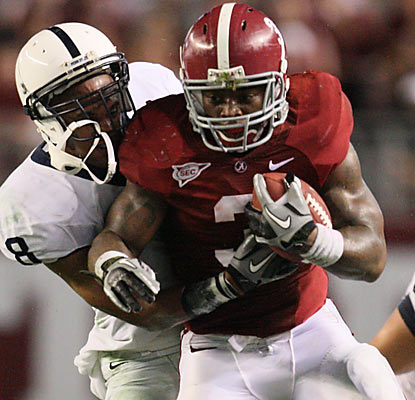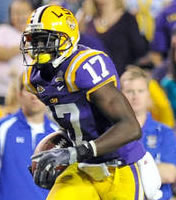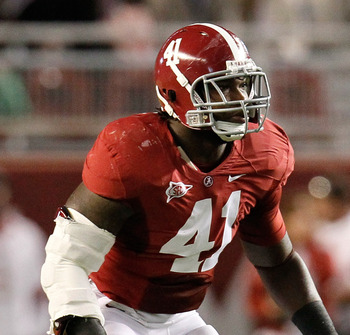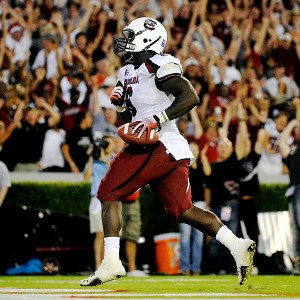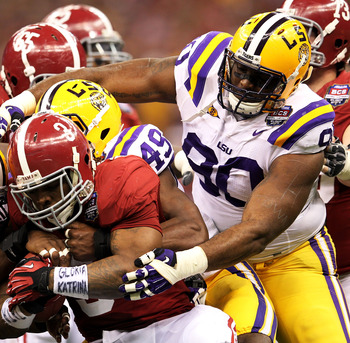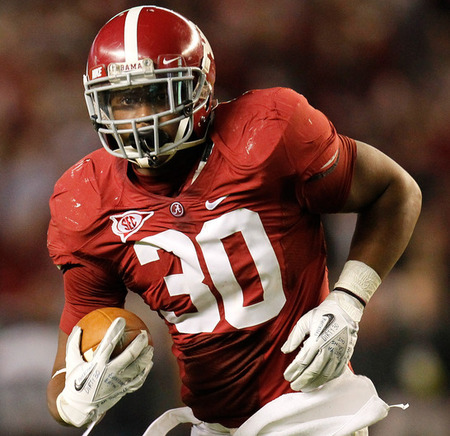
With the #12 pick in the 2012 draft, the Seattle Seahawks select...
If the Seahawks draft Courtney Upshaw or Melvin Ingram in round one, how would they fit into the defensive scheme? Are they LEO pass rushers? Would they play the WILL or the SAM? Are they orthodox 4-3 rushers who take over the Raheem Brock role?
These questions are asked more than any other on this blog. This probably means I’ve not done a good enough job describing why they fit in Seattle, so hopefully we can get to the bottom of this today. Firstly, I was grateful to hear Scott Enyeart – USC beat writer – discussing the subject in a podcast for the HawkBlogger site today.
“The concept is an elephant defensive end. Basically it’s kind of a hybrid linebacker/defensive end type player who’s got some 3-4 principles and it was a way to generate some pass rush and also be really super effective against the run. That fast twitch, speedy edge rusher, that Justin Tuck type – I don’t know it that’s necessarily what Seattle wants because I think they want to be able to be effective against the run and not have a drop off and have to run certain players in the game and those types of things. So I think that’s Upshaw’s versatility over your traditional, you know, ‘LT – I’m a linebacker I’m going to get down on the line and be a pass rusher’. I think that’d he’d be able to be effective against the run and I think that’s what I like about him maybe over Ingram – versus the run. But I do think that maybe an ‘elephant’ role, that would put him in the Clay Mathews class as he was used under Pete Carroll.”
The Seahawks need an elephant. Someone who continues to improve the team’s strong run defense, but also helps create more of a pass rush threat to compliment the LEO Chris Clemons. The player needs to be a three-down type who can line up at the same time as Red Bryant and Clemons. He needs to be in on any play call – 3rd and short against the run, 1st and 20 against the pass. He needs to read well in space, be aggressive against the run and get to the quarterback. He doesn’t need to be Jason Pierre-Paul or DeMarcus Ware, because this is another one of Pete Carroll’s specialist roles. The Seahawks won’t be drafting a prospect who necessarily puts up the big numbers or has the rare athleticism, but as part of a collective group, they have an essential role to play.
Since Carroll arrived in Seattle – facing a substantial rebuild as big as any in the NFL – he’s had to be both radical and patient. This off-season presents an opportunity to address the linebacker position, with David Hawthorne and Leroy Hill both entering the free-agent market and with other needs (QB, OL, DB, WR etc) addressed, at least for the immediate future. This coincides with a wealth of talent in the particular target areas discussed here.
I’ve included part of a presentation conducted by Carroll at a Nike coaching clinic during his time as Head Coach at USC. The colored words below are Carroll’s, per Trojan Football Analysis. Although there’s quite a lot of detail and X’s and O’s to this piece, it does explain the team’s base defense and how Upshaw or Ingram would be used as an ‘elephant’ or SLB if they’re taken with the 12th overall pick.
Pete Carroll:
The front of the defense is called a “4-3 under” defense. We use it in combination with different secondary schemes such as Cover 1, 2, 3, or man to man coverage, etc. I’ll start out by explaining the 4-3 under in conjunction with Cover 1. In this case we’ll call it Under-Cover-1 Flex (Diagram 1). The flex call means that free safety is going to the split end side of the offense. The word flex is just a term we use in reference to the split end side of the offensive line. The tight end side we call the solid side. From this front we get a “gap control” type of play. When you put a defensive lineman in a gap and tell him he has to control the gap he can play very aggressively. He can aggressively attack the line of scrimmage and not just read and react.
The more the attacking oriented the defense is the better off it will be. Obviously when you come off the ball, sometimes it is run and sometimes it is pass. We like to be in the mode of attacking the line of scrimmage, so when it is a pass we will get pressure on the quarterback.
Diagram 1. 4-3 Under-Cover 1-Flex Front

With this basic front we can get eight players in the box area of this defense on run plays. We are going to stop the run on defense very well when we use this front. In this defense we outnumber the offense. The defense has more players at the line than the offense can block.
The SLB plays the tight end in man-to-man with this front using outside leverage as he is aligned in a loose 9 technique. The SLB can not get hooked as he is playing outside leverage on all blocks. The nose tackle (NT) is in a 1 technique to the strong side. The defensive tackle (DT) is in a three technique to the weak side. The ends (DE) are in a 5 technique on the offensive tackles. The MLB has responsibility for the strong side B gap and the WLB for the weak side A gap.
The free safety (FS) is playing down to the line of scrimmage on run plays and is responsible for the number two receiver to the weak side of the formation on pass plays. He plays the receiver as well with outside leverage. It should allow him to play really aggressive in the running game because the running back can not beat the free safety coming out of the backfield. The WLB and MLB are bracketed on the other running back playing him in and out with outside leverage. The corners are matched up with the WR’s man-to-man in this scheme.
The thing that is challenging is the MLB defending the play action plays. However, he knows that he is vulnerable and can overplay to where he is vulnerable.
No matter what coverage you are playing you have to convince your players to win their leverage side. If the coach tells a player to play outside leverage and complains when a receiver catches a ball to his inside, the coach is wrong. When we give them a leverage side, we are telling them to just do that aspect right at least.
To take this even further for example we tell our corners to play inside leverage (i.e. to the inside shoulder of the receiver) in this defense. This helps the corner avoid giving up the big play to the inside of the field. If you want them to play the out route towards the sideline you have to give them someone playing support over the top. There is not a corner in college or the NFL that can both play the out routes and also avoid giving up the deep ball to the inside. You have to be realistic as to what your players can do. They only way a corner can play inside leverage and make a play on the out route is if the offense screws up or the quarterback makes a bad throw or the receiver runs a bad route. If you don’t understand that then you are asking the corner to do something he can’t do.
The flex side defensive end is playing on the outside shoulder of the offensive tackle in a 5 technique. He does not have to be a large player and can be more of a pass rushing end. The only thing he can not do is get hooked or reached by the defender and moved out of position. He can play pass first and still be effective. However he does have to maintain gap responsibility for the defense to work. The key to the defense is not getting hooked. If the solid side defensive end is aligned in the strong side C gap he simply can not get hooked. He has to control that gap as does each position on the defensive line.
If the offense comes out in a one back set everyone plays the same except for the free safety. He is still playing the number two receiver to the flex side but he has to move outside to cover him.
Diagram 2. One Back Set & Doubles
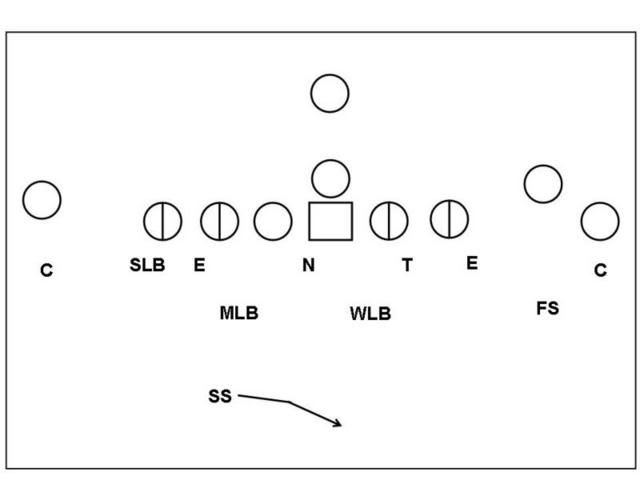
Diagram 3. Trips Set

To stay out of mismatches, the corners can take the wide receivers and match up with them (Diagram 4). If both wide receivers come to the same side, we can put both corners on them and cover the remaining receiver with the strong safety. If the corners are on the boundary side the free safety is in the middle. If the corners are on the other side of the field the strong safety is in the middle.
Diagram 4 Twin Doubles

The other one-back set we see a lot of is the one-back and two tight end set (Diagram 5). We put the free safety up on the second tight end. That gives you a problem with run support, but we can play it that way. Everything in the defense is basically the same.
Diagram 5. One-back and two tight ends set

If the offense comes out and gives the defense a two-back and two tight end look nothing changes for the defense (Diagram 6). The corner comes inside and plays man-to-man on the second tight end. Everyone else has the same match ups they had with any two-back sets.
Diagram 6. Two-back set with two tight ends

I want so show you how we react to the run so when you see the film you will know what we are doing (Diagram 7). Our defensive ends are aligned in 5 techniques. The nose tackle is in the A gap to the strong side in a one technique. The weak side defensive tackle is in a 3 technique off the outside shoulder of the guard. The WLB has the A gap to the weak side, but on plays to the strong side he has to get over the center’s block quickly. He cheats somewhat to the strong side with his alignment.
Everyone on the defense is turning the play inside. No one can ever get hooked. The MLB has the strong side B gap. If he is attacking in the B gap, he meets the block and turns it back inside. He plays with his head and outside arm free taking the block on with his inside shoulder. The free safety is our backside player. If the ball breaks back to the weak side A gap he has to make the play there. If there is a reverse run back the other way he has to make that play also. He generally does not cross the center line to make many plays.
Diagram 7. Strong side run responsibility

On the strong side if the offense is lined up in an I formation they have only four blockers to that side. The defense has four defenders and the WLB flowing fast to that side. Everyone on the defense is knocking the ball back inside to the WLB on this play.
If the ball is run to the weak side the MLB becomes the backside run player (Diagram 8). His play depends upon the direction of the run. He has to first defend against any cut back runs through the strong side B gap. If he needs to run through the backside B gap on plays away from him he can. The free safety can do the same thing on the plays away from him. If you ask the MLB to play the cutback and to get over the top then he is not going to be able to be aggressive.
Diagram 8. Weak side run responsibility

On plays to the strong side everyone plays with their outside arm free. If the SLB gets a down block from the tight end he rides him down and looks into the back field for the next block coming at him. On that block we ask him to wrong arm the block and bounce the ball outside. With that type of play we get what we call backer force. The MLB sees the power play going off tackle. He knows the SLB is going to bounce the play. He comes over the top and plays the ball with the strong safety coming up late to play the ball from the outside. Everyone plays with their outside arm free.
There are various adjustments we can make with our personnel. We can take our nose tackle and move him head-up onto the guard for example into what we call a G position. What we normally do is slant back to where we came from. As long as the defender keeps the ball on his inside shoulder he can play as fast as he wants to.
We can also use our base alignment to show overload to one side and then slant back to the other side before the snap of the ball. That is the flexibility of the defense.
There is a lot of flexibility for changing the force in this defensive scheme. If the offense picks up on the fact that the free safety is your weak side force man then they can develop schemes to make it hard for him. All we do then is to change the force on the play from the free safety to the corner in order to switch it up.
We can also change the force by slanting the defensive 3 technique and 5 techniques inside and scraping the WLB outside. We bring the corner off his wide out and make him the force man. He is playing the number 2 wide receiver out of the backfield and thus is the force man on the run to him. The free safety then rolls over the top of the corner into the deep half of the field. If you don’t want to play him in man-to-man you can play zone. With this kind of force change you can play quarter zone coverage to the strong side and half coverage to the weak side.
Most of the time we play our corners in some form of press coverage and have at least one safety deep in the hole for protection against the big play. Against some of the more spread out offenses we will back off our corners. With some spread formations we want to get the defensive backs eyes on the football. The deep safety is a player that is close to my heart. That is what I played. The deep safety has to play two routes. He has to defend the seam route and the post route. That is all I ask him to play. He has to find the seam route from the number two receiver. If there are two of them then he has to get in the middle and play them both. On the post route he has to stay on top of that route. That is easy to do but it becomes harder as offenses do more of it and get better at it.
In general we flip flop our defense. The SLB always goes to the tight end side. We often employ a rush and drop end from either side of the line. The rush guy goes with the SLB and the drop end goes with the WLB. The MLB aligns then to the SLB side of the play. The corners match up with the wide receivers and the safeties flip flop to the passing strength and running strength of the formation. This is our base defense.
As you can see, the base defense has a linebacker playing up at the LOS in each call. The determination to be strong against the run is described in detail, and a player like Courtney Upshaw would provide the kind of edge control the defense requires. The big issue that is often referred to on this blog is how Upshaw would deal in coverage versus a tight end, but I think this is adaptable. Carroll has consistently taken players (Red Bryant being the key example) and played up to their strengths, while minimising the weaknesses. Suggesting a possible adaptation or manipulation to suit a player such as Upshaw is not about changing the entire concept of the defense, it’s about limiting a weakness while still benefiting from the positives.
In many ways Upshaw is ideal for the elephant in that he can provide solid run defense but still rush the passer, as Enyeart testified in his quote at the top of this piece. If covering certain tight ends is an issue (it would be, certainly compared to a more athletic prospect such as Melvin Ingram and even he’d struggle against the best) then why can’t you work around that? One of Seattle’s tall and physical corners can move inside, the MLB can come across and cover. I would describe it as acknowledging that you can’t always find the perfect player for every role. If a prospect is ideal in every way but for a certain aspect (ie. coverage vs TE’s) then you work around it to benefit from the other positive aspects. That’s not such a major stretch and not a great detachment from game-planning to face a certain prospect in a given week. After all, it could be that in some cases against weaker tight-end opponents, you revert back to the original base-plan anyway. You’re not going to likely put a linebacker on Jimmy Graham anyway.
I think the information above will help paint a better picture of how Upshaw and Ingram would be used as an aggressive hybrid of the DE/LB position – an elephant. The reason Upshaw might have the edge is due to his superiority vs the run and his physicality, plus his ability to read in space. Ingram would still fill the role and would have other advantages, they’re just not as valued as the run defense aspect. I think the other goal aside from drafting for this position is to make the MLB and WLB as athletic as possible. Hawthorne is unsigned for a reason and I think the Seahawks would really like to install linebackers who can cover as almost a premium. This is why I believe Zach Brown could be an option, because his major positive coming into the league will be sideline-to-sideline mobility and coverage. If you have Brown covering the TE and one of the big corners in a 2TE set, you’re maxing out the potential of your elephant.
Elsewhere…
Mark Eckel of the Times has been surveying NFL scouts and personnel on the top defensive prospects in the 2012 draft. Here’s some of the quotes he received for the defensive lineman:
On Michael Brockers: “I think he’s the best DT in the draft. He can play the run and he has some pass rush.”
On Fletcher Cox: “He’s OK. He can be a bit of an enigma. He’s getting a little overhyped because of the Combine. He’s perfect for a 3-4 team as an end, I don’t like him as much in a 4-3.”
On Dontari Poe: “He’ll be overdrafted. He did all of that at the Combine, so some team will take him way higher than he should go. I mean watch him play, just watch. He didn’t do anything. And he wasn’t playing at a very high level, either. All I know is he had one sack last year and it came against Austin Peay. You probably didn’t even know Austin Peay had a football team.”
On Kendall Reyes: “Of all of them, he’s a pure 4-3 tackle, he can play the 3-technique for you.” Another scouts is quoted as saying: “He’s soft. He doesn’t finish.”
On Devon Still: “He was very inconsistent from what I saw. He’s going to need a lot of work. I think he’ll be all right, just not right away.”
On Jerel Worthy: “I don’t like him. He’s lazy and he’s not productive.”
On Alameda Ta’amu: “He’s a classic 3-4 nose. I’m not sure I like him in a 4-3.”
On Quinton Coples: “He’s good as hell, but he’s nuts. I’m not sure what’s up with him. I’d put him at left end in a 4-3, but he could do everything if he wants it.”
On Whitney Mercilus: “Those 16 sacks are a little deceiving. A lot of it was just cleaning up. He’s not good against the run at all, so he might have to be a situational pass rusher.”
On Jared Crick: “A lot of his sacks came when (Ndamukong) Suh was still there. A real try-hard guy. What you call a plugger.”


